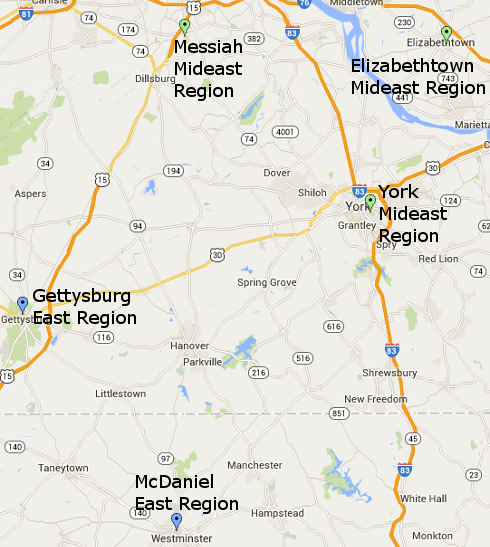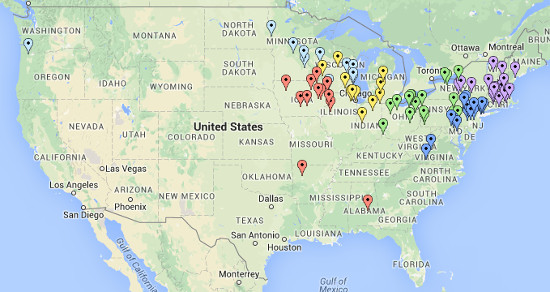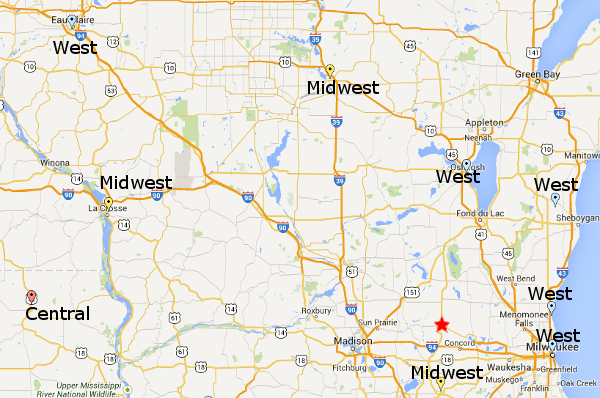Regional Alignment and the Growth of Division III Wrestling
Division III Regional Alignment for 2014-2015
The 2011-2012 season was the first to feature the current regional qualification system. The Division III teams were each placed into one of six regional tournaments with the top three finishers at each weight qualifying for the NCAA Championships. Prior to 2012, each conference/regional championship was allotted a different number of qualifiers based on a formula that accounted for performance of that conference in previous NCAA Championships. This was also the era of wildcard meetings where coaches voted on the most deserving qualifiers when the number allotted to a conference was not a multiple of ten. The past few years have seen the total number of qualifiers increase from 160 to 170 under the wildcard system and now to the current 180 under the regional system.
| Region | Teams |
|---|---|
| West | 11 |
| Midwest | 12 |
| Central | 13 |
| Mideast | 18 |
| East | 18 |
| Northeast | 18 |
| Total | 90 |
The move to the regional system was prompted primarily by the desire of the NCAA to remove historical data (i.e., results from prior seasons) from the process that determines who qualifies for the NCAA Championships in all sports. When Division I wrestling moved to its current system involving coaches rankings, RPI, and Gold and Silver Standards (explained here), that left Division III wrestling as the only championship (out of nearly 90 championships at the time) in the entirety of the NCAA still relying on historical data.
In order to completely remove historical data from the qualifying process, the regions would ideally be determined solely on a geographical basis with an even number of teams in each region. That said, it is possible to argue that some regions should have fewer teams in order to minimize travel distances. Regardless, the system put in place grouped the teams into six regions. For 2015, the three regions in the eastern half of the wrestling map are approximately 50% larger than that three regions in the western half. (These numbers reflect the fact that Yeshiva has not yet attended a regional and that Maranatha has shuttered their program, at least for this year)
 There are also a few places on the map where things look a little strange. Some of this was done in order to keep some of the all-sport conferences (OAC, Centennial, IIAC) together, but it is worth pointing out.
There are also a few places on the map where things look a little strange. Some of this was done in order to keep some of the all-sport conferences (OAC, Centennial, IIAC) together, but it is worth pointing out.
First, there’s the East/Mideast divide pictured here. It is a little bit strange, but it makes some sense when considering that the idea was to keep some conferences together, so Centennial members McDaniel and Gettysburg stay with their conference teams that are further to the East.
It is an open question as of now whether the desire to keep conference teams grouped together will remain important as teams are added and the regions are realigned. The NCAA has indicated that the current maximum region size is 18 teams which is why the addition of Daniel Webster College to the Northeast Region this year necessitated moving Oswego into the Mideast Region. Now there are three regions at this maximum of 18. In order to hold regions at or below 18 teams without major realignment, multiple teams will have to change regions next year in order to fit Greensboro and Hampden-Sydney into regions that make geographical sense. Adrian and Millikin can likely slot in somewhere without causing major movement.
Things are also a bit mixed up in the western part of the Division III map.
There are four teams (five if Maranatha, represented by the red star, was competing this year) that are pretty far to the east and are farther to the east than at least three teams that are not in the West region.
It is expected that that regions will be evaluated and realigned after the 2015-2016 season. Here is one proposal for how to do so. These are some of the guidelines used to generate what is to follow.
1. Conferences do not have to stay together
2. Keep the same, or close to the same, number of teams in each region
3. Simple boundaries between regions are better than complicated ones
4. Current or past team quality is not considered. This is the only way to truly eliminate the use of historical data.
5. This includes all teams that have either announced new teams for next year or are in the provisional period of joining the NCAA. Some of these teams will not yet be eligible for the postseason for 2016-2017.
This results in a list of 97 teams (Yeshiva and Maranatha were excluded from this alignment but could easily be added should they return to postseason competition). With 97 teams, there are five regions with 16 teams and one with 17 teams. No team should have to cross a regional border to travel to any other team in their region. Click below to see a proposed regional map including these 97 teams.
Division III Regional Realignment Proposal Map | List of Teams by Proposed Region
Some caveats to consider:
1. It is likely that more schools will start teams between now and the 2016-2017 season. This season, there were three new teams. Next season, there will be at least four. This map only accounts for what we know now.
2. This is not necessarily the absolute best arrangement of teams. It is possible to meet the guidelines above but come up with a different, or even better, proposal.
3. At some point, keeping six regions will not make sense as there will be too many teams. If a seventh or eighth regional is added, the whole system will have to change if the tournament stays at 180 qualifiers.
With any luck, Division III wrestling will continue to grow, and this proposal, along with any others, will have to adjust to account for the growing demand for wrestling at Division III colleges.


